Business Idea Generation and Evaluation of Feasibility
VerifiedAdded on 2023/05/28
|14
|4148
|115
AI Summary
The study deals with various problem identifications of recycling engineering wastes at Togo, Africa. It demonstrates how business ideas are helpful to use technical and professional skills. It is also helpful to use the locally available raw materials for products and services.
Contribute Materials
Your contribution can guide someone’s learning journey. Share your
documents today.
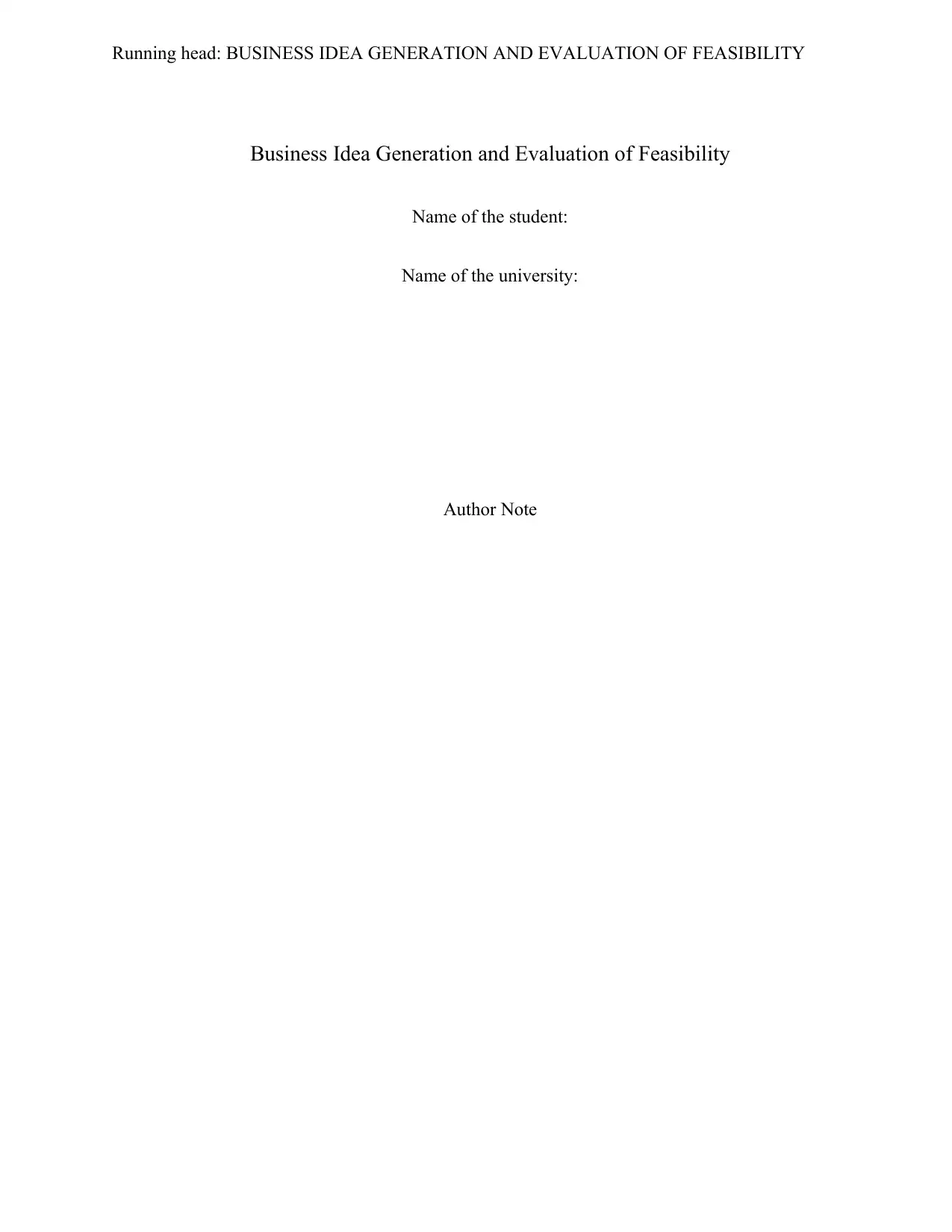
Running head: BUSINESS IDEA GENERATION AND EVALUATION OF FEASIBILITY
Business Idea Generation and Evaluation of Feasibility
Name of the student:
Name of the university:
Author Note
Business Idea Generation and Evaluation of Feasibility
Name of the student:
Name of the university:
Author Note
Secure Best Marks with AI Grader
Need help grading? Try our AI Grader for instant feedback on your assignments.
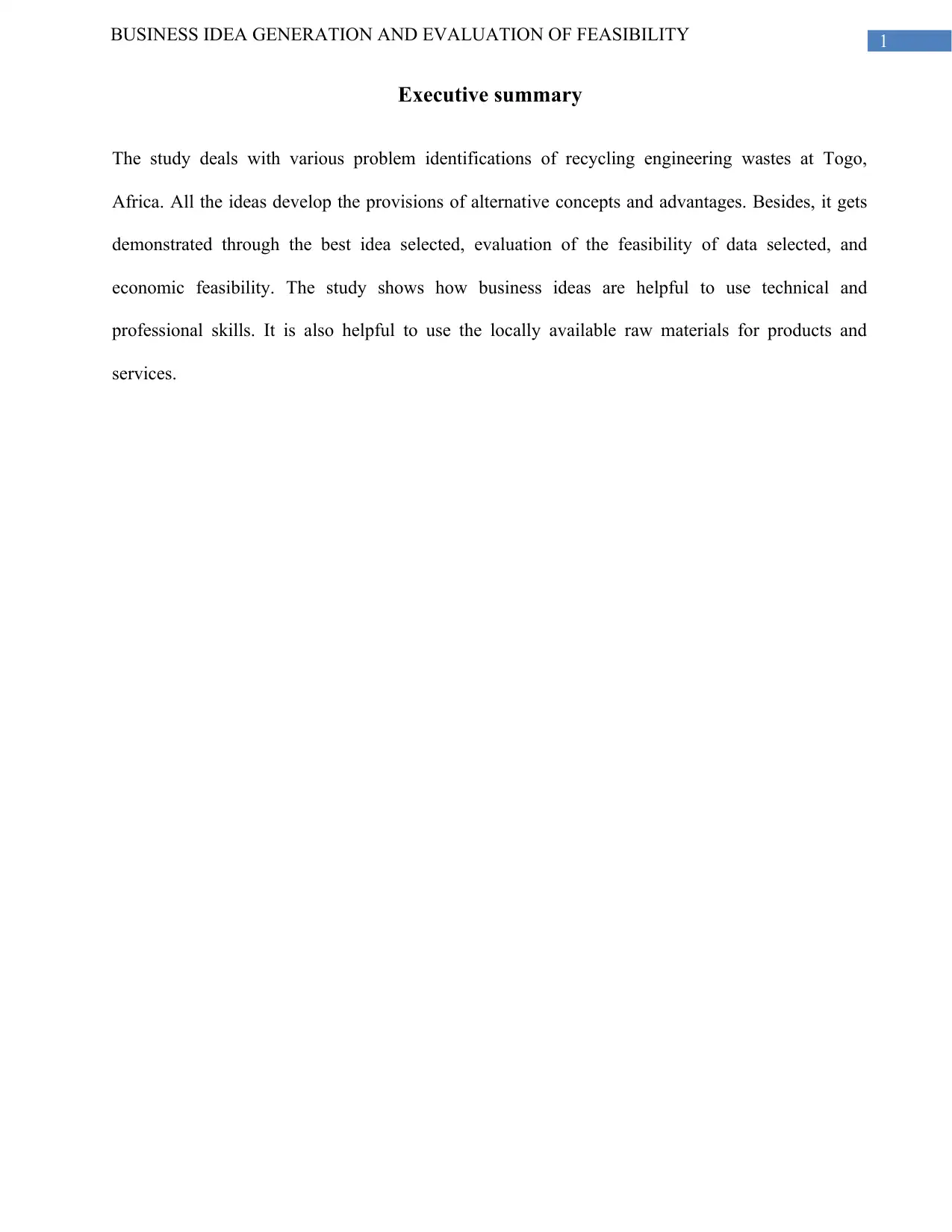
1BUSINESS IDEA GENERATION AND EVALUATION OF FEASIBILITY
Executive summary
The study deals with various problem identifications of recycling engineering wastes at Togo,
Africa. All the ideas develop the provisions of alternative concepts and advantages. Besides, it gets
demonstrated through the best idea selected, evaluation of the feasibility of data selected, and
economic feasibility. The study shows how business ideas are helpful to use technical and
professional skills. It is also helpful to use the locally available raw materials for products and
services.
Executive summary
The study deals with various problem identifications of recycling engineering wastes at Togo,
Africa. All the ideas develop the provisions of alternative concepts and advantages. Besides, it gets
demonstrated through the best idea selected, evaluation of the feasibility of data selected, and
economic feasibility. The study shows how business ideas are helpful to use technical and
professional skills. It is also helpful to use the locally available raw materials for products and
services.
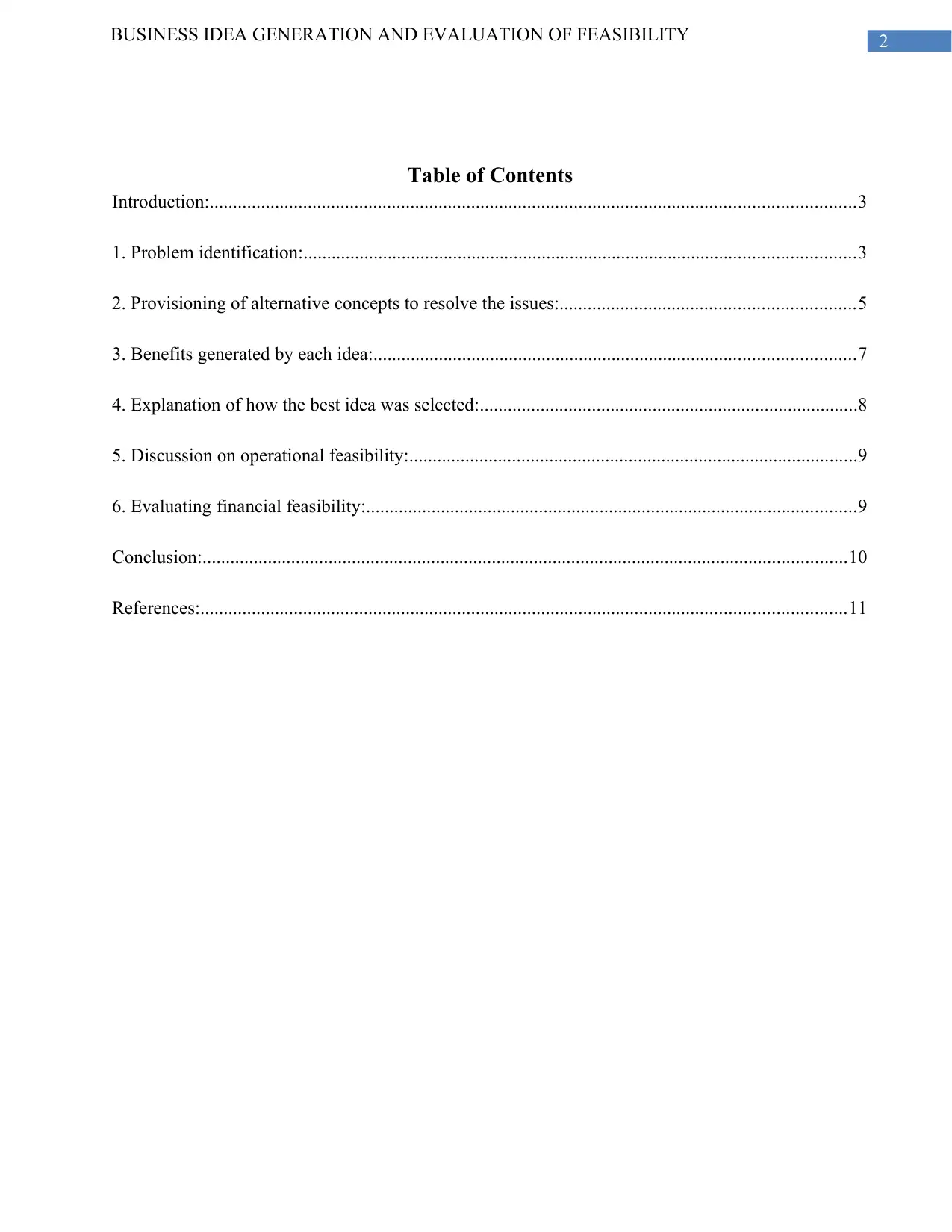
2BUSINESS IDEA GENERATION AND EVALUATION OF FEASIBILITY
Table of Contents
Introduction:..........................................................................................................................................3
1. Problem identification:......................................................................................................................3
2. Provisioning of alternative concepts to resolve the issues:...............................................................5
3. Benefits generated by each idea:.......................................................................................................7
4. Explanation of how the best idea was selected:.................................................................................8
5. Discussion on operational feasibility:................................................................................................9
6. Evaluating financial feasibility:.........................................................................................................9
Conclusion:..........................................................................................................................................10
References:..........................................................................................................................................11
Table of Contents
Introduction:..........................................................................................................................................3
1. Problem identification:......................................................................................................................3
2. Provisioning of alternative concepts to resolve the issues:...............................................................5
3. Benefits generated by each idea:.......................................................................................................7
4. Explanation of how the best idea was selected:.................................................................................8
5. Discussion on operational feasibility:................................................................................................9
6. Evaluating financial feasibility:.........................................................................................................9
Conclusion:..........................................................................................................................................10
References:..........................................................................................................................................11
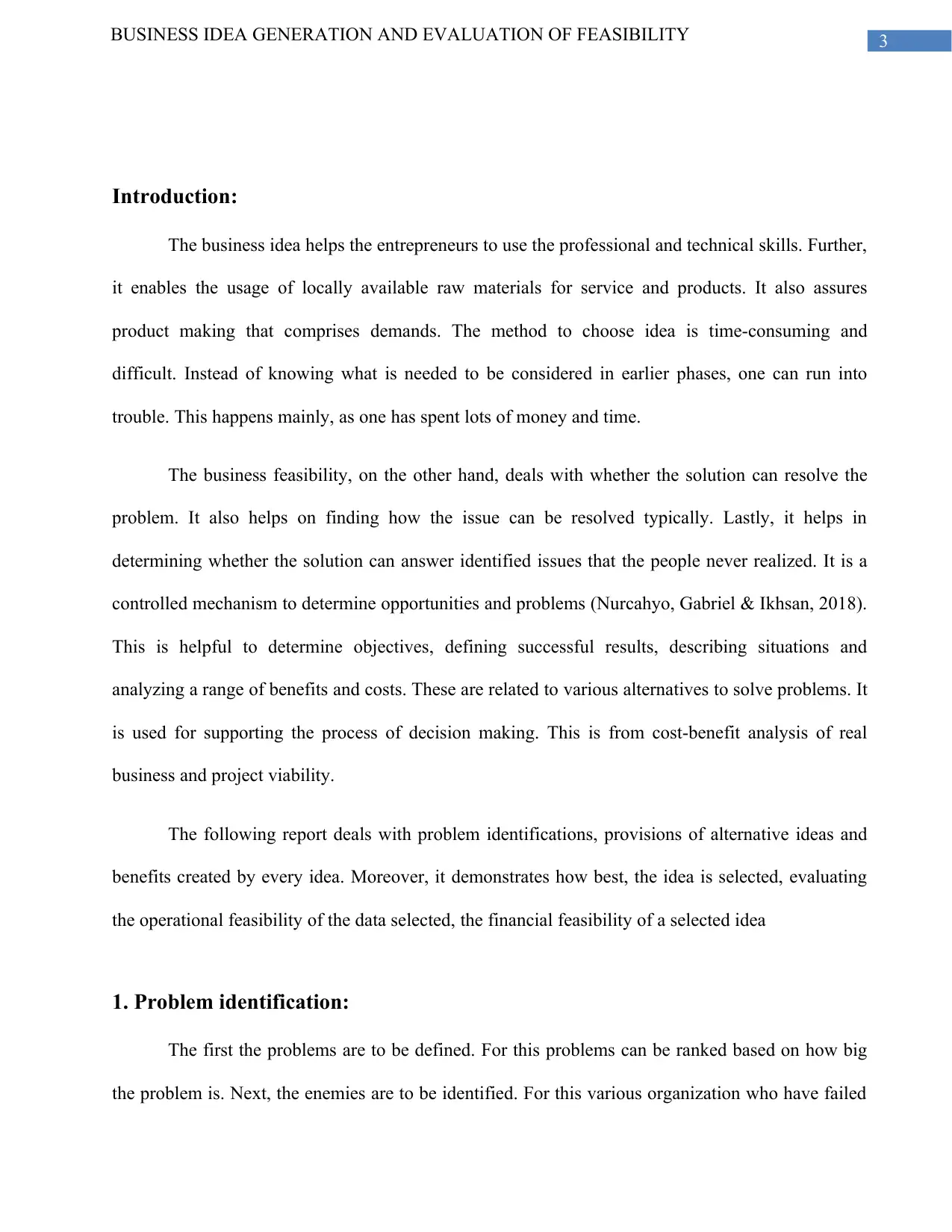
3BUSINESS IDEA GENERATION AND EVALUATION OF FEASIBILITY
Introduction:
The business idea helps the entrepreneurs to use the professional and technical skills. Further,
it enables the usage of locally available raw materials for service and products. It also assures
product making that comprises demands. The method to choose idea is time-consuming and
difficult. Instead of knowing what is needed to be considered in earlier phases, one can run into
trouble. This happens mainly, as one has spent lots of money and time.
The business feasibility, on the other hand, deals with whether the solution can resolve the
problem. It also helps on finding how the issue can be resolved typically. Lastly, it helps in
determining whether the solution can answer identified issues that the people never realized. It is a
controlled mechanism to determine opportunities and problems (Nurcahyo, Gabriel & Ikhsan, 2018).
This is helpful to determine objectives, defining successful results, describing situations and
analyzing a range of benefits and costs. These are related to various alternatives to solve problems. It
is used for supporting the process of decision making. This is from cost-benefit analysis of real
business and project viability.
The following report deals with problem identifications, provisions of alternative ideas and
benefits created by every idea. Moreover, it demonstrates how best, the idea is selected, evaluating
the operational feasibility of the data selected, the financial feasibility of a selected idea
1. Problem identification:
The first the problems are to be defined. For this problems can be ranked based on how big
the problem is. Next, the enemies are to be identified. For this various organization who have failed
Introduction:
The business idea helps the entrepreneurs to use the professional and technical skills. Further,
it enables the usage of locally available raw materials for service and products. It also assures
product making that comprises demands. The method to choose idea is time-consuming and
difficult. Instead of knowing what is needed to be considered in earlier phases, one can run into
trouble. This happens mainly, as one has spent lots of money and time.
The business feasibility, on the other hand, deals with whether the solution can resolve the
problem. It also helps on finding how the issue can be resolved typically. Lastly, it helps in
determining whether the solution can answer identified issues that the people never realized. It is a
controlled mechanism to determine opportunities and problems (Nurcahyo, Gabriel & Ikhsan, 2018).
This is helpful to determine objectives, defining successful results, describing situations and
analyzing a range of benefits and costs. These are related to various alternatives to solve problems. It
is used for supporting the process of decision making. This is from cost-benefit analysis of real
business and project viability.
The following report deals with problem identifications, provisions of alternative ideas and
benefits created by every idea. Moreover, it demonstrates how best, the idea is selected, evaluating
the operational feasibility of the data selected, the financial feasibility of a selected idea
1. Problem identification:
The first the problems are to be defined. For this problems can be ranked based on how big
the problem is. Next, the enemies are to be identified. For this various organization who have failed
Secure Best Marks with AI Grader
Need help grading? Try our AI Grader for instant feedback on your assignments.
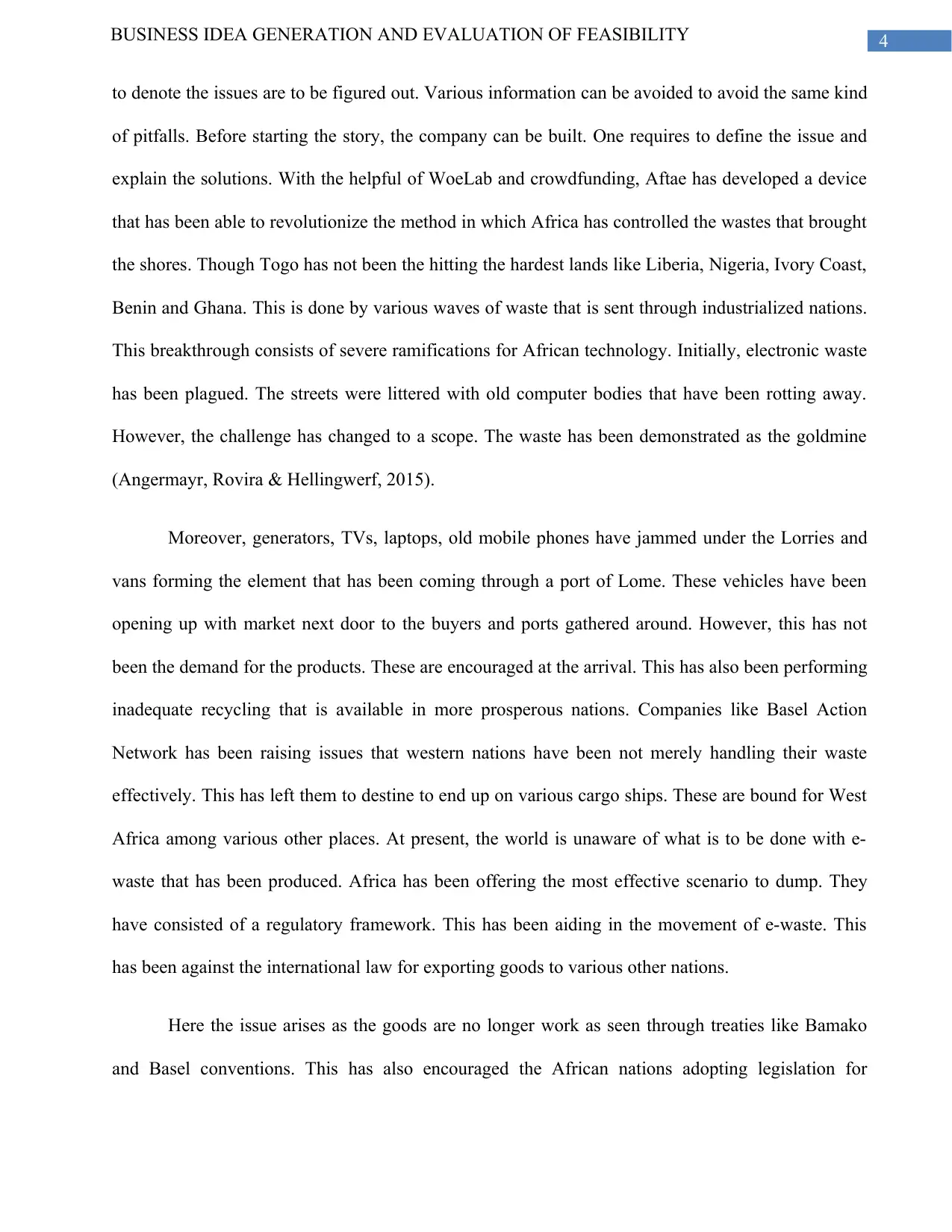
4BUSINESS IDEA GENERATION AND EVALUATION OF FEASIBILITY
to denote the issues are to be figured out. Various information can be avoided to avoid the same kind
of pitfalls. Before starting the story, the company can be built. One requires to define the issue and
explain the solutions. With the helpful of WoeLab and crowdfunding, Aftae has developed a device
that has been able to revolutionize the method in which Africa has controlled the wastes that brought
the shores. Though Togo has not been the hitting the hardest lands like Liberia, Nigeria, Ivory Coast,
Benin and Ghana. This is done by various waves of waste that is sent through industrialized nations.
This breakthrough consists of severe ramifications for African technology. Initially, electronic waste
has been plagued. The streets were littered with old computer bodies that have been rotting away.
However, the challenge has changed to a scope. The waste has been demonstrated as the goldmine
(Angermayr, Rovira & Hellingwerf, 2015).
Moreover, generators, TVs, laptops, old mobile phones have jammed under the Lorries and
vans forming the element that has been coming through a port of Lome. These vehicles have been
opening up with market next door to the buyers and ports gathered around. However, this has not
been the demand for the products. These are encouraged at the arrival. This has also been performing
inadequate recycling that is available in more prosperous nations. Companies like Basel Action
Network has been raising issues that western nations have been not merely handling their waste
effectively. This has left them to destine to end up on various cargo ships. These are bound for West
Africa among various other places. At present, the world is unaware of what is to be done with e-
waste that has been produced. Africa has been offering the most effective scenario to dump. They
have consisted of a regulatory framework. This has been aiding in the movement of e-waste. This
has been against the international law for exporting goods to various other nations.
Here the issue arises as the goods are no longer work as seen through treaties like Bamako
and Basel conventions. This has also encouraged the African nations adopting legislation for
to denote the issues are to be figured out. Various information can be avoided to avoid the same kind
of pitfalls. Before starting the story, the company can be built. One requires to define the issue and
explain the solutions. With the helpful of WoeLab and crowdfunding, Aftae has developed a device
that has been able to revolutionize the method in which Africa has controlled the wastes that brought
the shores. Though Togo has not been the hitting the hardest lands like Liberia, Nigeria, Ivory Coast,
Benin and Ghana. This is done by various waves of waste that is sent through industrialized nations.
This breakthrough consists of severe ramifications for African technology. Initially, electronic waste
has been plagued. The streets were littered with old computer bodies that have been rotting away.
However, the challenge has changed to a scope. The waste has been demonstrated as the goldmine
(Angermayr, Rovira & Hellingwerf, 2015).
Moreover, generators, TVs, laptops, old mobile phones have jammed under the Lorries and
vans forming the element that has been coming through a port of Lome. These vehicles have been
opening up with market next door to the buyers and ports gathered around. However, this has not
been the demand for the products. These are encouraged at the arrival. This has also been performing
inadequate recycling that is available in more prosperous nations. Companies like Basel Action
Network has been raising issues that western nations have been not merely handling their waste
effectively. This has left them to destine to end up on various cargo ships. These are bound for West
Africa among various other places. At present, the world is unaware of what is to be done with e-
waste that has been produced. Africa has been offering the most effective scenario to dump. They
have consisted of a regulatory framework. This has been aiding in the movement of e-waste. This
has been against the international law for exporting goods to various other nations.
Here the issue arises as the goods are no longer work as seen through treaties like Bamako
and Basel conventions. This has also encouraged the African nations adopting legislation for
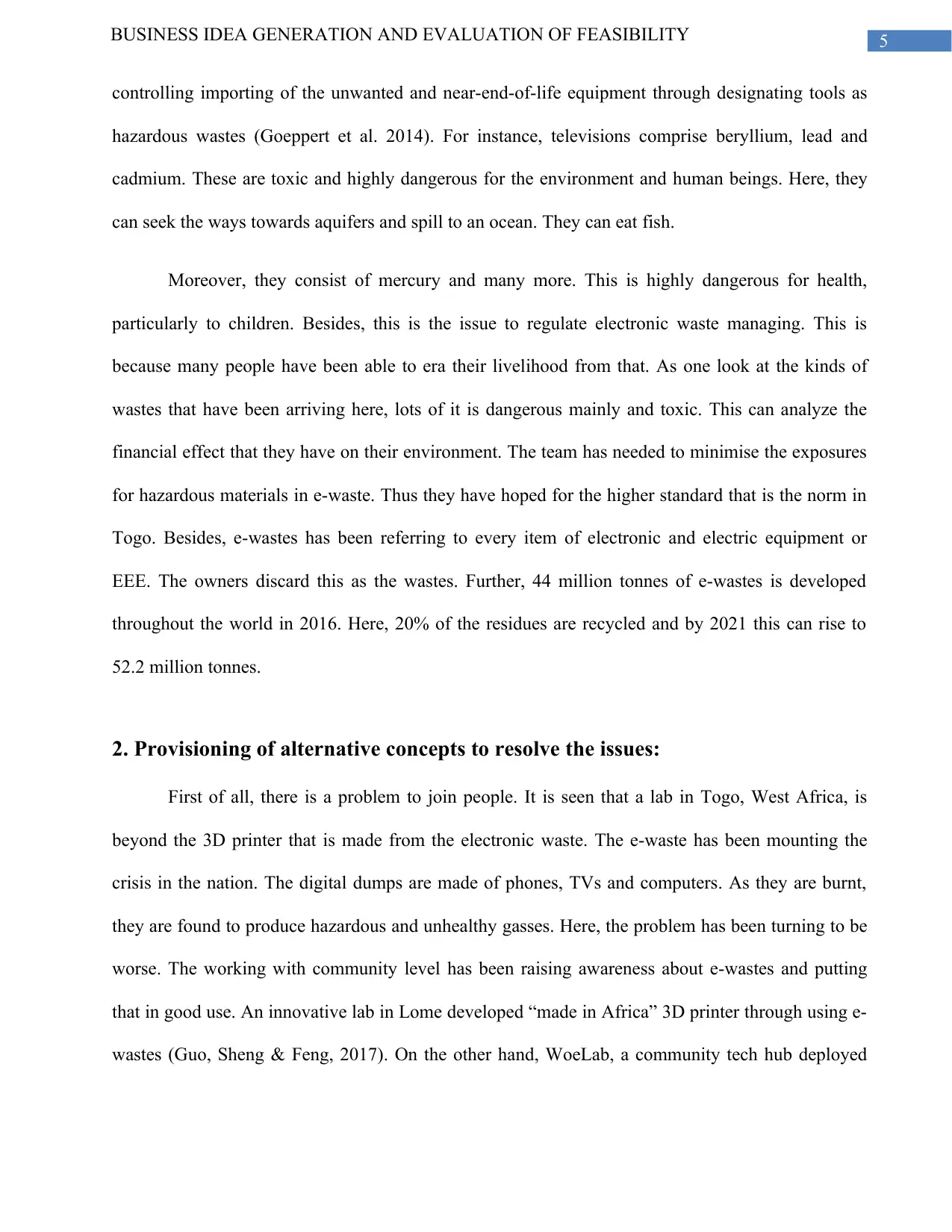
5BUSINESS IDEA GENERATION AND EVALUATION OF FEASIBILITY
controlling importing of the unwanted and near-end-of-life equipment through designating tools as
hazardous wastes (Goeppert et al. 2014). For instance, televisions comprise beryllium, lead and
cadmium. These are toxic and highly dangerous for the environment and human beings. Here, they
can seek the ways towards aquifers and spill to an ocean. They can eat fish.
Moreover, they consist of mercury and many more. This is highly dangerous for health,
particularly to children. Besides, this is the issue to regulate electronic waste managing. This is
because many people have been able to era their livelihood from that. As one look at the kinds of
wastes that have been arriving here, lots of it is dangerous mainly and toxic. This can analyze the
financial effect that they have on their environment. The team has needed to minimise the exposures
for hazardous materials in e-waste. Thus they have hoped for the higher standard that is the norm in
Togo. Besides, e-wastes has been referring to every item of electronic and electric equipment or
EEE. The owners discard this as the wastes. Further, 44 million tonnes of e-wastes is developed
throughout the world in 2016. Here, 20% of the residues are recycled and by 2021 this can rise to
52.2 million tonnes.
2. Provisioning of alternative concepts to resolve the issues:
First of all, there is a problem to join people. It is seen that a lab in Togo, West Africa, is
beyond the 3D printer that is made from the electronic waste. The e-waste has been mounting the
crisis in the nation. The digital dumps are made of phones, TVs and computers. As they are burnt,
they are found to produce hazardous and unhealthy gasses. Here, the problem has been turning to be
worse. The working with community level has been raising awareness about e-wastes and putting
that in good use. An innovative lab in Lome developed “made in Africa” 3D printer through using e-
wastes (Guo, Sheng & Feng, 2017). On the other hand, WoeLab, a community tech hub deployed
controlling importing of the unwanted and near-end-of-life equipment through designating tools as
hazardous wastes (Goeppert et al. 2014). For instance, televisions comprise beryllium, lead and
cadmium. These are toxic and highly dangerous for the environment and human beings. Here, they
can seek the ways towards aquifers and spill to an ocean. They can eat fish.
Moreover, they consist of mercury and many more. This is highly dangerous for health,
particularly to children. Besides, this is the issue to regulate electronic waste managing. This is
because many people have been able to era their livelihood from that. As one look at the kinds of
wastes that have been arriving here, lots of it is dangerous mainly and toxic. This can analyze the
financial effect that they have on their environment. The team has needed to minimise the exposures
for hazardous materials in e-waste. Thus they have hoped for the higher standard that is the norm in
Togo. Besides, e-wastes has been referring to every item of electronic and electric equipment or
EEE. The owners discard this as the wastes. Further, 44 million tonnes of e-wastes is developed
throughout the world in 2016. Here, 20% of the residues are recycled and by 2021 this can rise to
52.2 million tonnes.
2. Provisioning of alternative concepts to resolve the issues:
First of all, there is a problem to join people. It is seen that a lab in Togo, West Africa, is
beyond the 3D printer that is made from the electronic waste. The e-waste has been mounting the
crisis in the nation. The digital dumps are made of phones, TVs and computers. As they are burnt,
they are found to produce hazardous and unhealthy gasses. Here, the problem has been turning to be
worse. The working with community level has been raising awareness about e-wastes and putting
that in good use. An innovative lab in Lome developed “made in Africa” 3D printer through using e-
wastes (Guo, Sheng & Feng, 2017). On the other hand, WoeLab, a community tech hub deployed
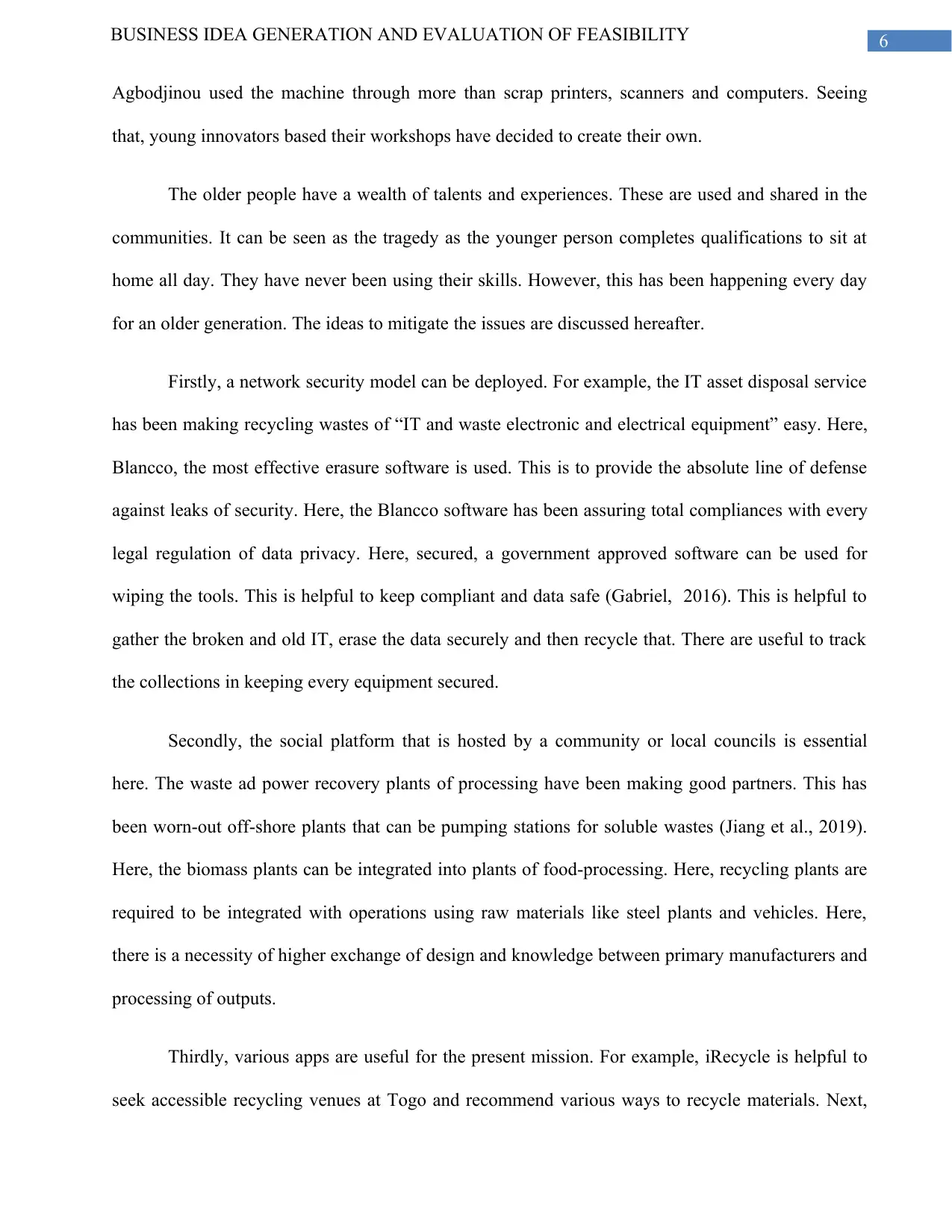
6BUSINESS IDEA GENERATION AND EVALUATION OF FEASIBILITY
Agbodjinou used the machine through more than scrap printers, scanners and computers. Seeing
that, young innovators based their workshops have decided to create their own.
The older people have a wealth of talents and experiences. These are used and shared in the
communities. It can be seen as the tragedy as the younger person completes qualifications to sit at
home all day. They have never been using their skills. However, this has been happening every day
for an older generation. The ideas to mitigate the issues are discussed hereafter.
Firstly, a network security model can be deployed. For example, the IT asset disposal service
has been making recycling wastes of “IT and waste electronic and electrical equipment” easy. Here,
Blancco, the most effective erasure software is used. This is to provide the absolute line of defense
against leaks of security. Here, the Blancco software has been assuring total compliances with every
legal regulation of data privacy. Here, secured, a government approved software can be used for
wiping the tools. This is helpful to keep compliant and data safe (Gabriel, 2016). This is helpful to
gather the broken and old IT, erase the data securely and then recycle that. There are useful to track
the collections in keeping every equipment secured.
Secondly, the social platform that is hosted by a community or local councils is essential
here. The waste ad power recovery plants of processing have been making good partners. This has
been worn-out off-shore plants that can be pumping stations for soluble wastes (Jiang et al., 2019).
Here, the biomass plants can be integrated into plants of food-processing. Here, recycling plants are
required to be integrated with operations using raw materials like steel plants and vehicles. Here,
there is a necessity of higher exchange of design and knowledge between primary manufacturers and
processing of outputs.
Thirdly, various apps are useful for the present mission. For example, iRecycle is helpful to
seek accessible recycling venues at Togo and recommend various ways to recycle materials. Next,
Agbodjinou used the machine through more than scrap printers, scanners and computers. Seeing
that, young innovators based their workshops have decided to create their own.
The older people have a wealth of talents and experiences. These are used and shared in the
communities. It can be seen as the tragedy as the younger person completes qualifications to sit at
home all day. They have never been using their skills. However, this has been happening every day
for an older generation. The ideas to mitigate the issues are discussed hereafter.
Firstly, a network security model can be deployed. For example, the IT asset disposal service
has been making recycling wastes of “IT and waste electronic and electrical equipment” easy. Here,
Blancco, the most effective erasure software is used. This is to provide the absolute line of defense
against leaks of security. Here, the Blancco software has been assuring total compliances with every
legal regulation of data privacy. Here, secured, a government approved software can be used for
wiping the tools. This is helpful to keep compliant and data safe (Gabriel, 2016). This is helpful to
gather the broken and old IT, erase the data securely and then recycle that. There are useful to track
the collections in keeping every equipment secured.
Secondly, the social platform that is hosted by a community or local councils is essential
here. The waste ad power recovery plants of processing have been making good partners. This has
been worn-out off-shore plants that can be pumping stations for soluble wastes (Jiang et al., 2019).
Here, the biomass plants can be integrated into plants of food-processing. Here, recycling plants are
required to be integrated with operations using raw materials like steel plants and vehicles. Here,
there is a necessity of higher exchange of design and knowledge between primary manufacturers and
processing of outputs.
Thirdly, various apps are useful for the present mission. For example, iRecycle is helpful to
seek accessible recycling venues at Togo and recommend various ways to recycle materials. Next,
Paraphrase This Document
Need a fresh take? Get an instant paraphrase of this document with our AI Paraphraser
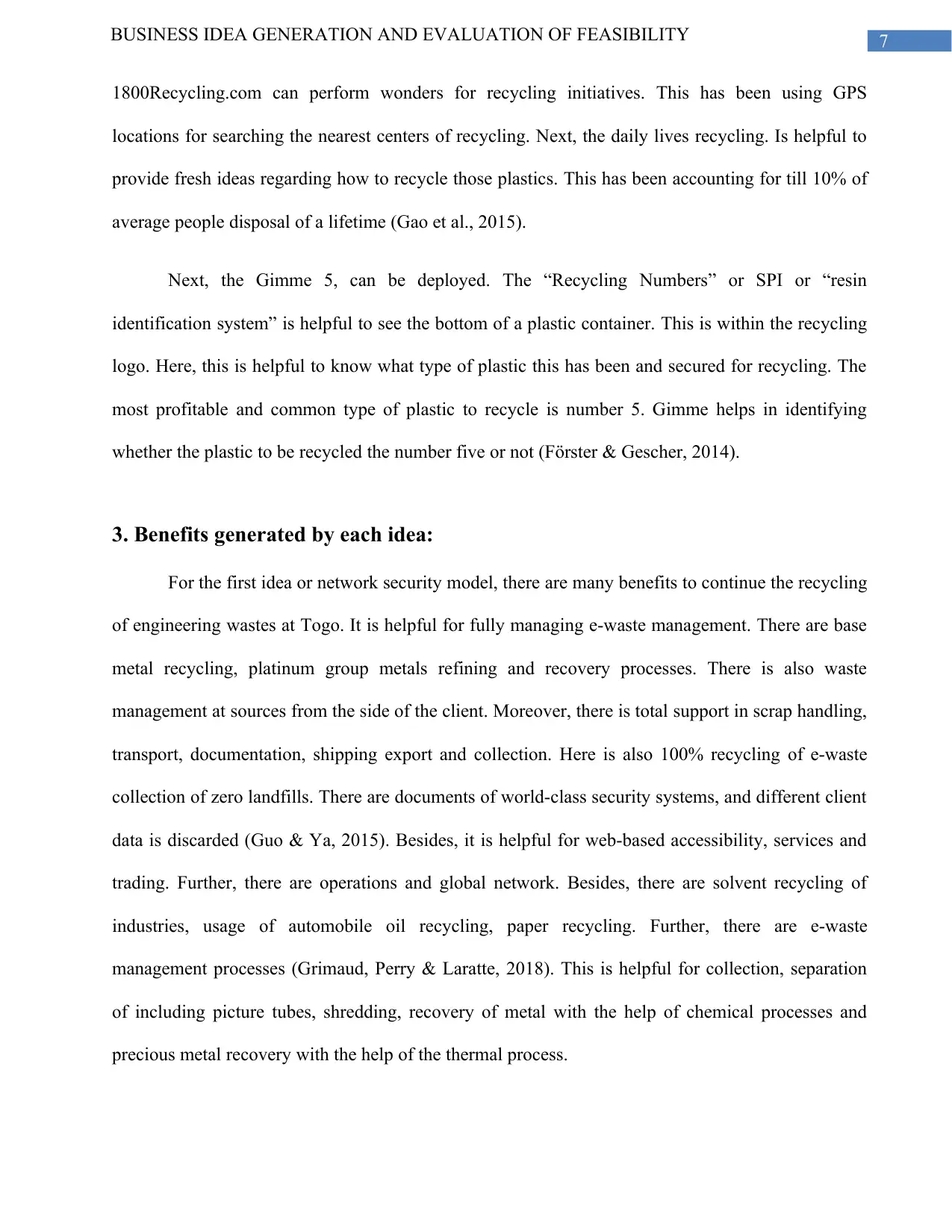
7BUSINESS IDEA GENERATION AND EVALUATION OF FEASIBILITY
1800Recycling.com can perform wonders for recycling initiatives. This has been using GPS
locations for searching the nearest centers of recycling. Next, the daily lives recycling. Is helpful to
provide fresh ideas regarding how to recycle those plastics. This has been accounting for till 10% of
average people disposal of a lifetime (Gao et al., 2015).
Next, the Gimme 5, can be deployed. The “Recycling Numbers” or SPI or “resin
identification system” is helpful to see the bottom of a plastic container. This is within the recycling
logo. Here, this is helpful to know what type of plastic this has been and secured for recycling. The
most profitable and common type of plastic to recycle is number 5. Gimme helps in identifying
whether the plastic to be recycled the number five or not (Förster & Gescher, 2014).
3. Benefits generated by each idea:
For the first idea or network security model, there are many benefits to continue the recycling
of engineering wastes at Togo. It is helpful for fully managing e-waste management. There are base
metal recycling, platinum group metals refining and recovery processes. There is also waste
management at sources from the side of the client. Moreover, there is total support in scrap handling,
transport, documentation, shipping export and collection. Here is also 100% recycling of e-waste
collection of zero landfills. There are documents of world-class security systems, and different client
data is discarded (Guo & Ya, 2015). Besides, it is helpful for web-based accessibility, services and
trading. Further, there are operations and global network. Besides, there are solvent recycling of
industries, usage of automobile oil recycling, paper recycling. Further, there are e-waste
management processes (Grimaud, Perry & Laratte, 2018). This is helpful for collection, separation
of including picture tubes, shredding, recovery of metal with the help of chemical processes and
precious metal recovery with the help of the thermal process.
1800Recycling.com can perform wonders for recycling initiatives. This has been using GPS
locations for searching the nearest centers of recycling. Next, the daily lives recycling. Is helpful to
provide fresh ideas regarding how to recycle those plastics. This has been accounting for till 10% of
average people disposal of a lifetime (Gao et al., 2015).
Next, the Gimme 5, can be deployed. The “Recycling Numbers” or SPI or “resin
identification system” is helpful to see the bottom of a plastic container. This is within the recycling
logo. Here, this is helpful to know what type of plastic this has been and secured for recycling. The
most profitable and common type of plastic to recycle is number 5. Gimme helps in identifying
whether the plastic to be recycled the number five or not (Förster & Gescher, 2014).
3. Benefits generated by each idea:
For the first idea or network security model, there are many benefits to continue the recycling
of engineering wastes at Togo. It is helpful for fully managing e-waste management. There are base
metal recycling, platinum group metals refining and recovery processes. There is also waste
management at sources from the side of the client. Moreover, there is total support in scrap handling,
transport, documentation, shipping export and collection. Here is also 100% recycling of e-waste
collection of zero landfills. There are documents of world-class security systems, and different client
data is discarded (Guo & Ya, 2015). Besides, it is helpful for web-based accessibility, services and
trading. Further, there are operations and global network. Besides, there are solvent recycling of
industries, usage of automobile oil recycling, paper recycling. Further, there are e-waste
management processes (Grimaud, Perry & Laratte, 2018). This is helpful for collection, separation
of including picture tubes, shredding, recovery of metal with the help of chemical processes and
precious metal recovery with the help of the thermal process.
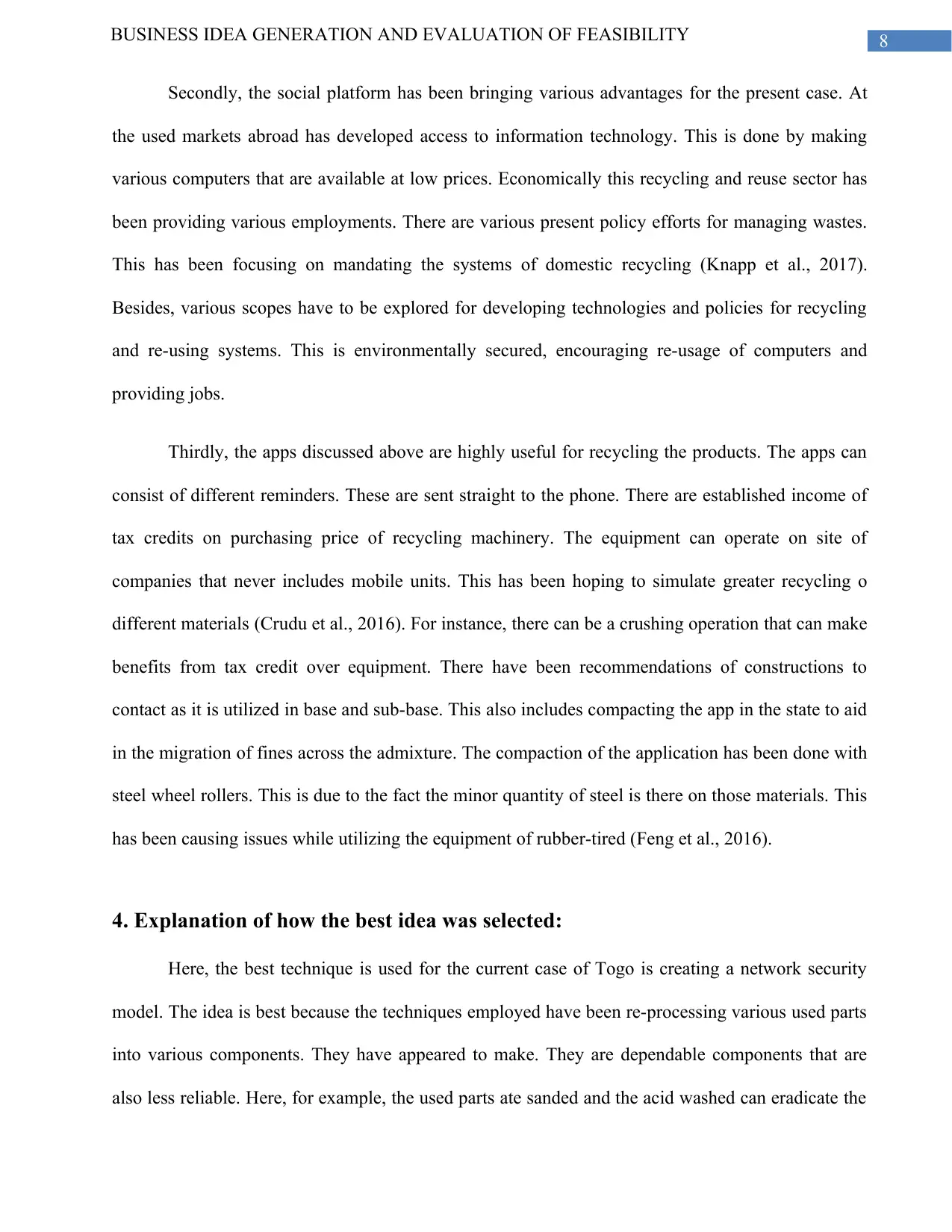
8BUSINESS IDEA GENERATION AND EVALUATION OF FEASIBILITY
Secondly, the social platform has been bringing various advantages for the present case. At
the used markets abroad has developed access to information technology. This is done by making
various computers that are available at low prices. Economically this recycling and reuse sector has
been providing various employments. There are various present policy efforts for managing wastes.
This has been focusing on mandating the systems of domestic recycling (Knapp et al., 2017).
Besides, various scopes have to be explored for developing technologies and policies for recycling
and re-using systems. This is environmentally secured, encouraging re-usage of computers and
providing jobs.
Thirdly, the apps discussed above are highly useful for recycling the products. The apps can
consist of different reminders. These are sent straight to the phone. There are established income of
tax credits on purchasing price of recycling machinery. The equipment can operate on site of
companies that never includes mobile units. This has been hoping to simulate greater recycling o
different materials (Crudu et al., 2016). For instance, there can be a crushing operation that can make
benefits from tax credit over equipment. There have been recommendations of constructions to
contact as it is utilized in base and sub-base. This also includes compacting the app in the state to aid
in the migration of fines across the admixture. The compaction of the application has been done with
steel wheel rollers. This is due to the fact the minor quantity of steel is there on those materials. This
has been causing issues while utilizing the equipment of rubber-tired (Feng et al., 2016).
4. Explanation of how the best idea was selected:
Here, the best technique is used for the current case of Togo is creating a network security
model. The idea is best because the techniques employed have been re-processing various used parts
into various components. They have appeared to make. They are dependable components that are
also less reliable. Here, for example, the used parts ate sanded and the acid washed can eradicate the
Secondly, the social platform has been bringing various advantages for the present case. At
the used markets abroad has developed access to information technology. This is done by making
various computers that are available at low prices. Economically this recycling and reuse sector has
been providing various employments. There are various present policy efforts for managing wastes.
This has been focusing on mandating the systems of domestic recycling (Knapp et al., 2017).
Besides, various scopes have to be explored for developing technologies and policies for recycling
and re-using systems. This is environmentally secured, encouraging re-usage of computers and
providing jobs.
Thirdly, the apps discussed above are highly useful for recycling the products. The apps can
consist of different reminders. These are sent straight to the phone. There are established income of
tax credits on purchasing price of recycling machinery. The equipment can operate on site of
companies that never includes mobile units. This has been hoping to simulate greater recycling o
different materials (Crudu et al., 2016). For instance, there can be a crushing operation that can make
benefits from tax credit over equipment. There have been recommendations of constructions to
contact as it is utilized in base and sub-base. This also includes compacting the app in the state to aid
in the migration of fines across the admixture. The compaction of the application has been done with
steel wheel rollers. This is due to the fact the minor quantity of steel is there on those materials. This
has been causing issues while utilizing the equipment of rubber-tired (Feng et al., 2016).
4. Explanation of how the best idea was selected:
Here, the best technique is used for the current case of Togo is creating a network security
model. The idea is best because the techniques employed have been re-processing various used parts
into various components. They have appeared to make. They are dependable components that are
also less reliable. Here, for example, the used parts ate sanded and the acid washed can eradicate the
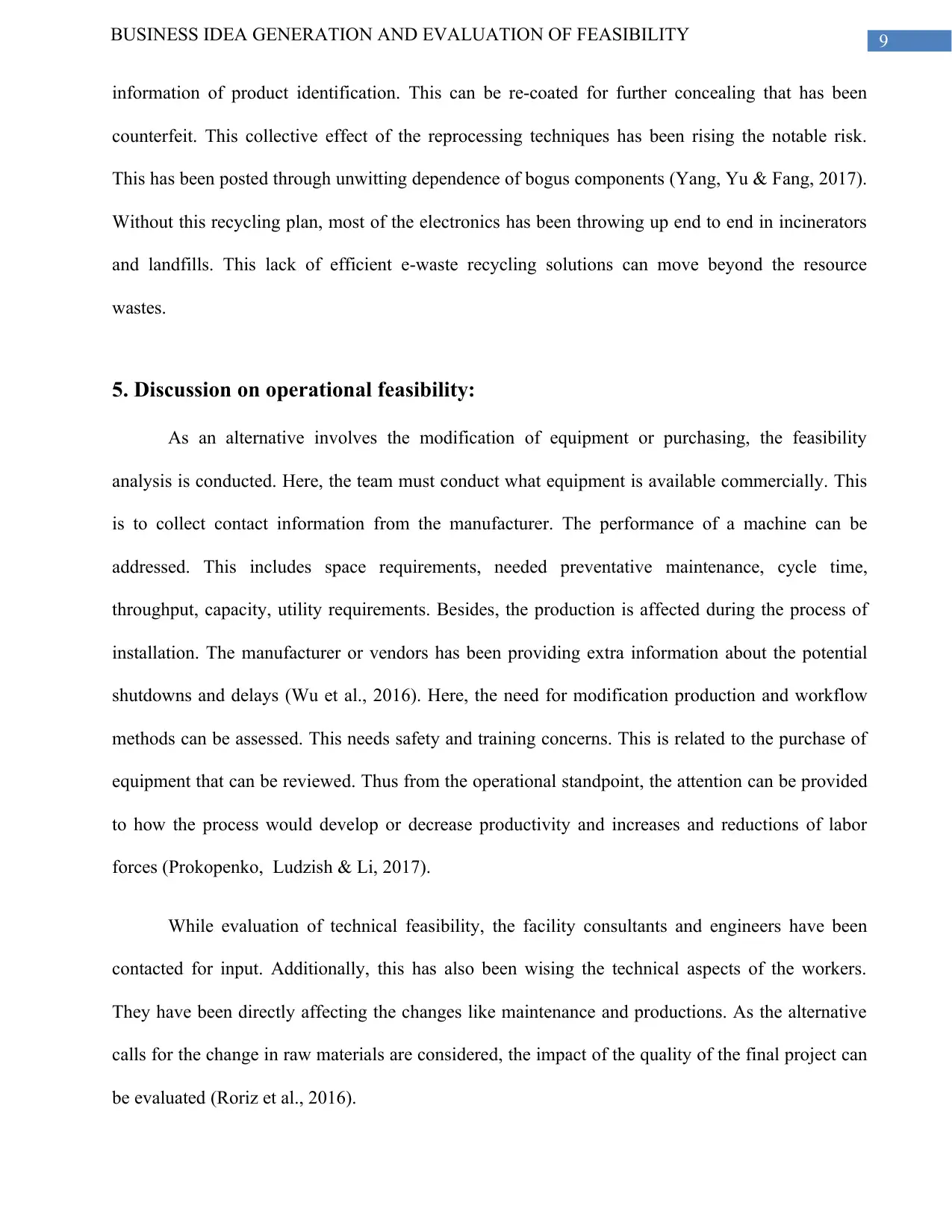
9BUSINESS IDEA GENERATION AND EVALUATION OF FEASIBILITY
information of product identification. This can be re-coated for further concealing that has been
counterfeit. This collective effect of the reprocessing techniques has been rising the notable risk.
This has been posted through unwitting dependence of bogus components (Yang, Yu & Fang, 2017).
Without this recycling plan, most of the electronics has been throwing up end to end in incinerators
and landfills. This lack of efficient e-waste recycling solutions can move beyond the resource
wastes.
5. Discussion on operational feasibility:
As an alternative involves the modification of equipment or purchasing, the feasibility
analysis is conducted. Here, the team must conduct what equipment is available commercially. This
is to collect contact information from the manufacturer. The performance of a machine can be
addressed. This includes space requirements, needed preventative maintenance, cycle time,
throughput, capacity, utility requirements. Besides, the production is affected during the process of
installation. The manufacturer or vendors has been providing extra information about the potential
shutdowns and delays (Wu et al., 2016). Here, the need for modification production and workflow
methods can be assessed. This needs safety and training concerns. This is related to the purchase of
equipment that can be reviewed. Thus from the operational standpoint, the attention can be provided
to how the process would develop or decrease productivity and increases and reductions of labor
forces (Prokopenko, Ludzish & Li, 2017).
While evaluation of technical feasibility, the facility consultants and engineers have been
contacted for input. Additionally, this has also been wising the technical aspects of the workers.
They have been directly affecting the changes like maintenance and productions. As the alternative
calls for the change in raw materials are considered, the impact of the quality of the final project can
be evaluated (Roriz et al., 2016).
information of product identification. This can be re-coated for further concealing that has been
counterfeit. This collective effect of the reprocessing techniques has been rising the notable risk.
This has been posted through unwitting dependence of bogus components (Yang, Yu & Fang, 2017).
Without this recycling plan, most of the electronics has been throwing up end to end in incinerators
and landfills. This lack of efficient e-waste recycling solutions can move beyond the resource
wastes.
5. Discussion on operational feasibility:
As an alternative involves the modification of equipment or purchasing, the feasibility
analysis is conducted. Here, the team must conduct what equipment is available commercially. This
is to collect contact information from the manufacturer. The performance of a machine can be
addressed. This includes space requirements, needed preventative maintenance, cycle time,
throughput, capacity, utility requirements. Besides, the production is affected during the process of
installation. The manufacturer or vendors has been providing extra information about the potential
shutdowns and delays (Wu et al., 2016). Here, the need for modification production and workflow
methods can be assessed. This needs safety and training concerns. This is related to the purchase of
equipment that can be reviewed. Thus from the operational standpoint, the attention can be provided
to how the process would develop or decrease productivity and increases and reductions of labor
forces (Prokopenko, Ludzish & Li, 2017).
While evaluation of technical feasibility, the facility consultants and engineers have been
contacted for input. Additionally, this has also been wising the technical aspects of the workers.
They have been directly affecting the changes like maintenance and productions. As the alternative
calls for the change in raw materials are considered, the impact of the quality of the final project can
be evaluated (Roriz et al., 2016).
Secure Best Marks with AI Grader
Need help grading? Try our AI Grader for instant feedback on your assignments.
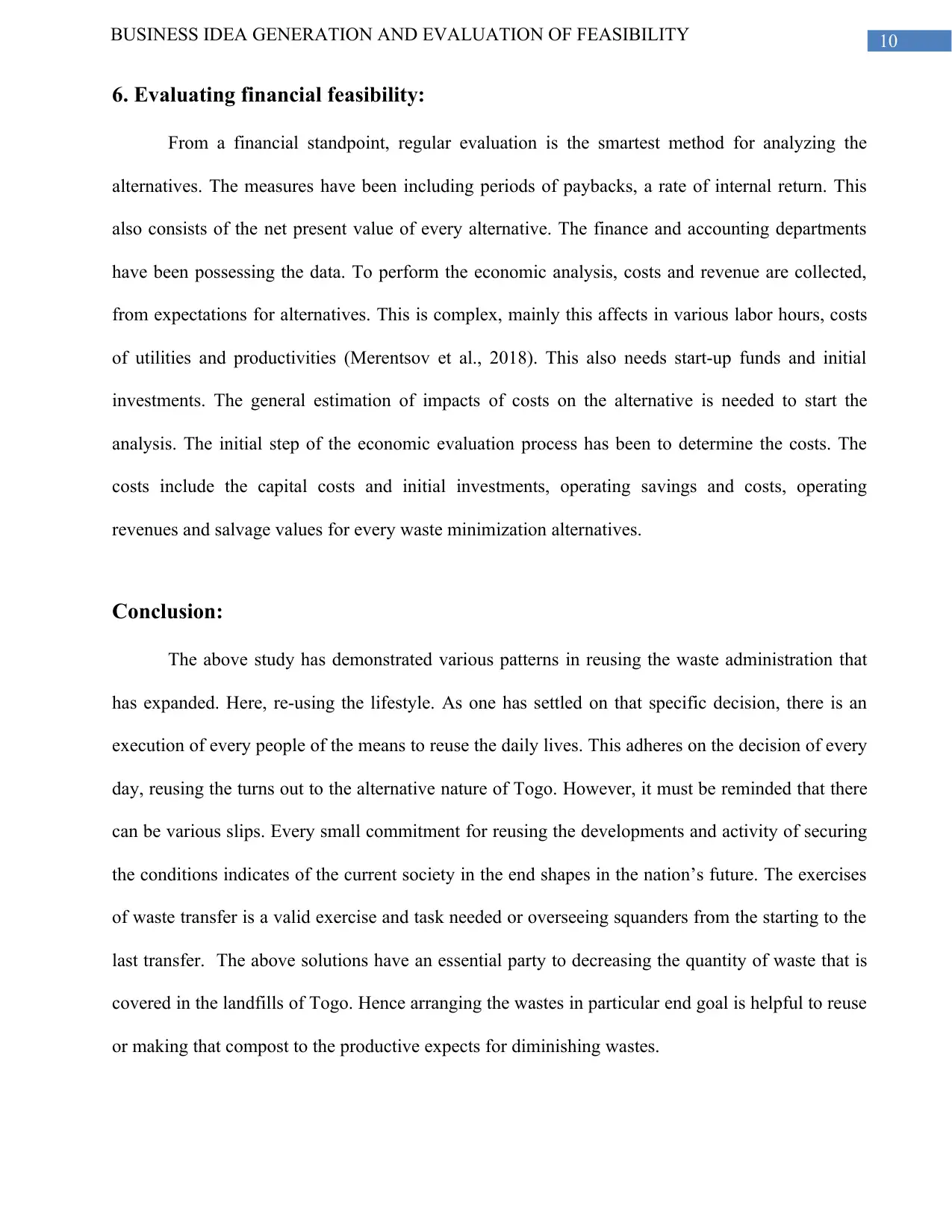
10BUSINESS IDEA GENERATION AND EVALUATION OF FEASIBILITY
6. Evaluating financial feasibility:
From a financial standpoint, regular evaluation is the smartest method for analyzing the
alternatives. The measures have been including periods of paybacks, a rate of internal return. This
also consists of the net present value of every alternative. The finance and accounting departments
have been possessing the data. To perform the economic analysis, costs and revenue are collected,
from expectations for alternatives. This is complex, mainly this affects in various labor hours, costs
of utilities and productivities (Merentsov et al., 2018). This also needs start-up funds and initial
investments. The general estimation of impacts of costs on the alternative is needed to start the
analysis. The initial step of the economic evaluation process has been to determine the costs. The
costs include the capital costs and initial investments, operating savings and costs, operating
revenues and salvage values for every waste minimization alternatives.
Conclusion:
The above study has demonstrated various patterns in reusing the waste administration that
has expanded. Here, re-using the lifestyle. As one has settled on that specific decision, there is an
execution of every people of the means to reuse the daily lives. This adheres on the decision of every
day, reusing the turns out to the alternative nature of Togo. However, it must be reminded that there
can be various slips. Every small commitment for reusing the developments and activity of securing
the conditions indicates of the current society in the end shapes in the nation’s future. The exercises
of waste transfer is a valid exercise and task needed or overseeing squanders from the starting to the
last transfer. The above solutions have an essential party to decreasing the quantity of waste that is
covered in the landfills of Togo. Hence arranging the wastes in particular end goal is helpful to reuse
or making that compost to the productive expects for diminishing wastes.
6. Evaluating financial feasibility:
From a financial standpoint, regular evaluation is the smartest method for analyzing the
alternatives. The measures have been including periods of paybacks, a rate of internal return. This
also consists of the net present value of every alternative. The finance and accounting departments
have been possessing the data. To perform the economic analysis, costs and revenue are collected,
from expectations for alternatives. This is complex, mainly this affects in various labor hours, costs
of utilities and productivities (Merentsov et al., 2018). This also needs start-up funds and initial
investments. The general estimation of impacts of costs on the alternative is needed to start the
analysis. The initial step of the economic evaluation process has been to determine the costs. The
costs include the capital costs and initial investments, operating savings and costs, operating
revenues and salvage values for every waste minimization alternatives.
Conclusion:
The above study has demonstrated various patterns in reusing the waste administration that
has expanded. Here, re-using the lifestyle. As one has settled on that specific decision, there is an
execution of every people of the means to reuse the daily lives. This adheres on the decision of every
day, reusing the turns out to the alternative nature of Togo. However, it must be reminded that there
can be various slips. Every small commitment for reusing the developments and activity of securing
the conditions indicates of the current society in the end shapes in the nation’s future. The exercises
of waste transfer is a valid exercise and task needed or overseeing squanders from the starting to the
last transfer. The above solutions have an essential party to decreasing the quantity of waste that is
covered in the landfills of Togo. Hence arranging the wastes in particular end goal is helpful to reuse
or making that compost to the productive expects for diminishing wastes.
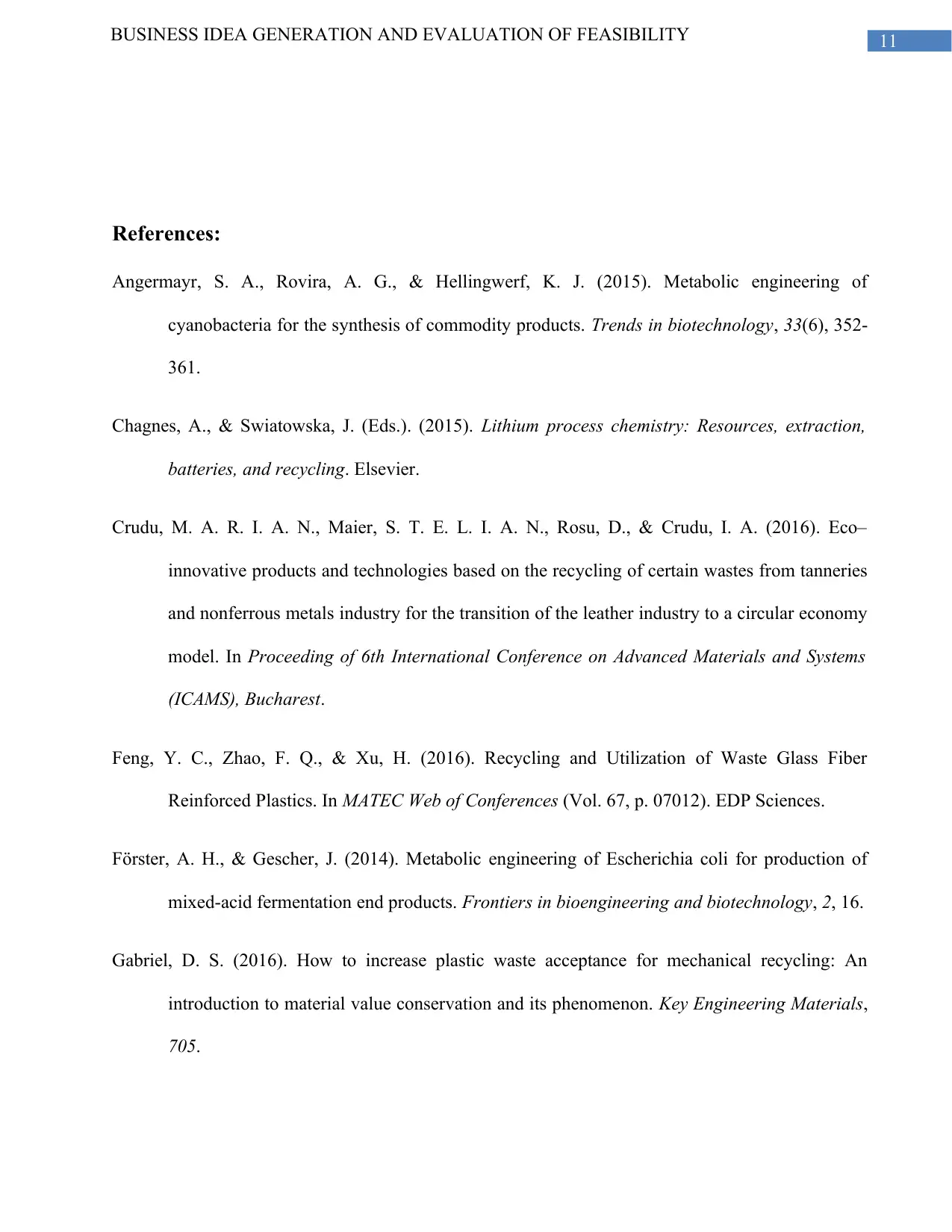
11BUSINESS IDEA GENERATION AND EVALUATION OF FEASIBILITY
References:
Angermayr, S. A., Rovira, A. G., & Hellingwerf, K. J. (2015). Metabolic engineering of
cyanobacteria for the synthesis of commodity products. Trends in biotechnology, 33(6), 352-
361.
Chagnes, A., & Swiatowska, J. (Eds.). (2015). Lithium process chemistry: Resources, extraction,
batteries, and recycling. Elsevier.
Crudu, M. A. R. I. A. N., Maier, S. T. E. L. I. A. N., Rosu, D., & Crudu, I. A. (2016). Eco–
innovative products and technologies based on the recycling of certain wastes from tanneries
and nonferrous metals industry for the transition of the leather industry to a circular economy
model. In Proceeding of 6th International Conference on Advanced Materials and Systems
(ICAMS), Bucharest.
Feng, Y. C., Zhao, F. Q., & Xu, H. (2016). Recycling and Utilization of Waste Glass Fiber
Reinforced Plastics. In MATEC Web of Conferences (Vol. 67, p. 07012). EDP Sciences.
Förster, A. H., & Gescher, J. (2014). Metabolic engineering of Escherichia coli for production of
mixed-acid fermentation end products. Frontiers in bioengineering and biotechnology, 2, 16.
Gabriel, D. S. (2016). How to increase plastic waste acceptance for mechanical recycling: An
introduction to material value conservation and its phenomenon. Key Engineering Materials,
705.
References:
Angermayr, S. A., Rovira, A. G., & Hellingwerf, K. J. (2015). Metabolic engineering of
cyanobacteria for the synthesis of commodity products. Trends in biotechnology, 33(6), 352-
361.
Chagnes, A., & Swiatowska, J. (Eds.). (2015). Lithium process chemistry: Resources, extraction,
batteries, and recycling. Elsevier.
Crudu, M. A. R. I. A. N., Maier, S. T. E. L. I. A. N., Rosu, D., & Crudu, I. A. (2016). Eco–
innovative products and technologies based on the recycling of certain wastes from tanneries
and nonferrous metals industry for the transition of the leather industry to a circular economy
model. In Proceeding of 6th International Conference on Advanced Materials and Systems
(ICAMS), Bucharest.
Feng, Y. C., Zhao, F. Q., & Xu, H. (2016). Recycling and Utilization of Waste Glass Fiber
Reinforced Plastics. In MATEC Web of Conferences (Vol. 67, p. 07012). EDP Sciences.
Förster, A. H., & Gescher, J. (2014). Metabolic engineering of Escherichia coli for production of
mixed-acid fermentation end products. Frontiers in bioengineering and biotechnology, 2, 16.
Gabriel, D. S. (2016). How to increase plastic waste acceptance for mechanical recycling: An
introduction to material value conservation and its phenomenon. Key Engineering Materials,
705.
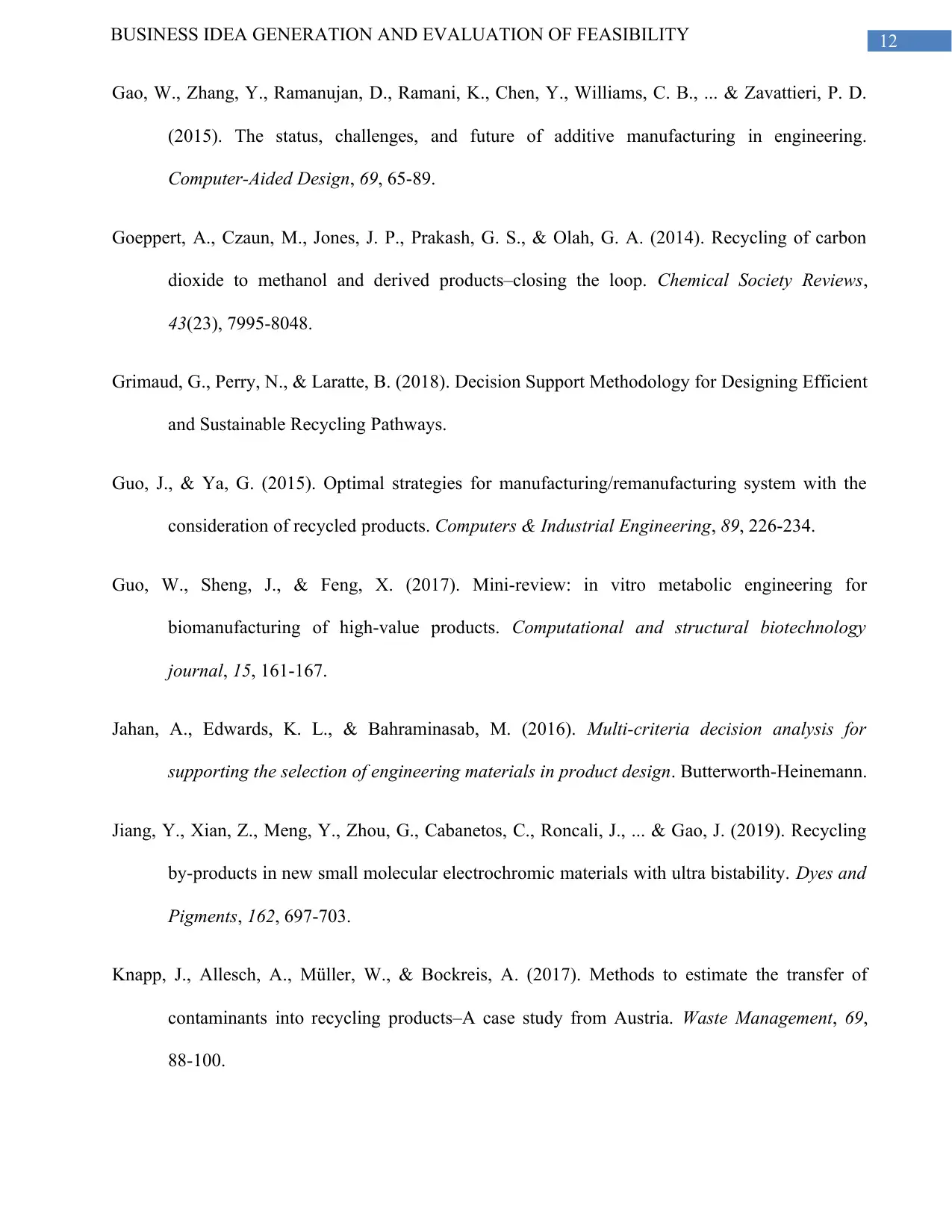
12BUSINESS IDEA GENERATION AND EVALUATION OF FEASIBILITY
Gao, W., Zhang, Y., Ramanujan, D., Ramani, K., Chen, Y., Williams, C. B., ... & Zavattieri, P. D.
(2015). The status, challenges, and future of additive manufacturing in engineering.
Computer-Aided Design, 69, 65-89.
Goeppert, A., Czaun, M., Jones, J. P., Prakash, G. S., & Olah, G. A. (2014). Recycling of carbon
dioxide to methanol and derived products–closing the loop. Chemical Society Reviews,
43(23), 7995-8048.
Grimaud, G., Perry, N., & Laratte, B. (2018). Decision Support Methodology for Designing Efficient
and Sustainable Recycling Pathways.
Guo, J., & Ya, G. (2015). Optimal strategies for manufacturing/remanufacturing system with the
consideration of recycled products. Computers & Industrial Engineering, 89, 226-234.
Guo, W., Sheng, J., & Feng, X. (2017). Mini-review: in vitro metabolic engineering for
biomanufacturing of high-value products. Computational and structural biotechnology
journal, 15, 161-167.
Jahan, A., Edwards, K. L., & Bahraminasab, M. (2016). Multi-criteria decision analysis for
supporting the selection of engineering materials in product design. Butterworth-Heinemann.
Jiang, Y., Xian, Z., Meng, Y., Zhou, G., Cabanetos, C., Roncali, J., ... & Gao, J. (2019). Recycling
by-products in new small molecular electrochromic materials with ultra bistability. Dyes and
Pigments, 162, 697-703.
Knapp, J., Allesch, A., Müller, W., & Bockreis, A. (2017). Methods to estimate the transfer of
contaminants into recycling products–A case study from Austria. Waste Management, 69,
88-100.
Gao, W., Zhang, Y., Ramanujan, D., Ramani, K., Chen, Y., Williams, C. B., ... & Zavattieri, P. D.
(2015). The status, challenges, and future of additive manufacturing in engineering.
Computer-Aided Design, 69, 65-89.
Goeppert, A., Czaun, M., Jones, J. P., Prakash, G. S., & Olah, G. A. (2014). Recycling of carbon
dioxide to methanol and derived products–closing the loop. Chemical Society Reviews,
43(23), 7995-8048.
Grimaud, G., Perry, N., & Laratte, B. (2018). Decision Support Methodology for Designing Efficient
and Sustainable Recycling Pathways.
Guo, J., & Ya, G. (2015). Optimal strategies for manufacturing/remanufacturing system with the
consideration of recycled products. Computers & Industrial Engineering, 89, 226-234.
Guo, W., Sheng, J., & Feng, X. (2017). Mini-review: in vitro metabolic engineering for
biomanufacturing of high-value products. Computational and structural biotechnology
journal, 15, 161-167.
Jahan, A., Edwards, K. L., & Bahraminasab, M. (2016). Multi-criteria decision analysis for
supporting the selection of engineering materials in product design. Butterworth-Heinemann.
Jiang, Y., Xian, Z., Meng, Y., Zhou, G., Cabanetos, C., Roncali, J., ... & Gao, J. (2019). Recycling
by-products in new small molecular electrochromic materials with ultra bistability. Dyes and
Pigments, 162, 697-703.
Knapp, J., Allesch, A., Müller, W., & Bockreis, A. (2017). Methods to estimate the transfer of
contaminants into recycling products–A case study from Austria. Waste Management, 69,
88-100.
Paraphrase This Document
Need a fresh take? Get an instant paraphrase of this document with our AI Paraphraser
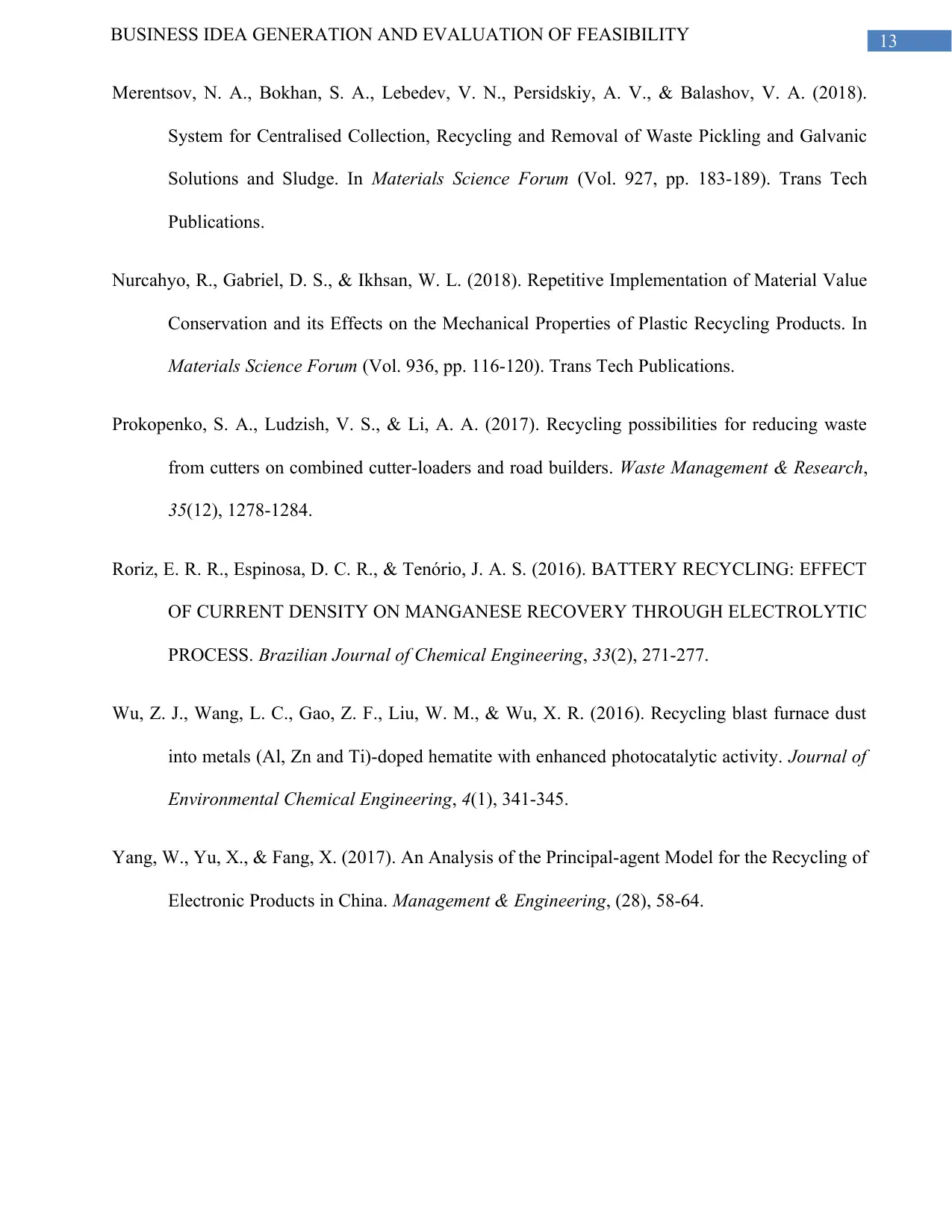
13BUSINESS IDEA GENERATION AND EVALUATION OF FEASIBILITY
Merentsov, N. A., Bokhan, S. A., Lebedev, V. N., Persidskiy, A. V., & Balashov, V. A. (2018).
System for Centralised Collection, Recycling and Removal of Waste Pickling and Galvanic
Solutions and Sludge. In Materials Science Forum (Vol. 927, pp. 183-189). Trans Tech
Publications.
Nurcahyo, R., Gabriel, D. S., & Ikhsan, W. L. (2018). Repetitive Implementation of Material Value
Conservation and its Effects on the Mechanical Properties of Plastic Recycling Products. In
Materials Science Forum (Vol. 936, pp. 116-120). Trans Tech Publications.
Prokopenko, S. A., Ludzish, V. S., & Li, A. A. (2017). Recycling possibilities for reducing waste
from cutters on combined cutter-loaders and road builders. Waste Management & Research,
35(12), 1278-1284.
Roriz, E. R. R., Espinosa, D. C. R., & Tenório, J. A. S. (2016). BATTERY RECYCLING: EFFECT
OF CURRENT DENSITY ON MANGANESE RECOVERY THROUGH ELECTROLYTIC
PROCESS. Brazilian Journal of Chemical Engineering, 33(2), 271-277.
Wu, Z. J., Wang, L. C., Gao, Z. F., Liu, W. M., & Wu, X. R. (2016). Recycling blast furnace dust
into metals (Al, Zn and Ti)-doped hematite with enhanced photocatalytic activity. Journal of
Environmental Chemical Engineering, 4(1), 341-345.
Yang, W., Yu, X., & Fang, X. (2017). An Analysis of the Principal-agent Model for the Recycling of
Electronic Products in China. Management & Engineering, (28), 58-64.
Merentsov, N. A., Bokhan, S. A., Lebedev, V. N., Persidskiy, A. V., & Balashov, V. A. (2018).
System for Centralised Collection, Recycling and Removal of Waste Pickling and Galvanic
Solutions and Sludge. In Materials Science Forum (Vol. 927, pp. 183-189). Trans Tech
Publications.
Nurcahyo, R., Gabriel, D. S., & Ikhsan, W. L. (2018). Repetitive Implementation of Material Value
Conservation and its Effects on the Mechanical Properties of Plastic Recycling Products. In
Materials Science Forum (Vol. 936, pp. 116-120). Trans Tech Publications.
Prokopenko, S. A., Ludzish, V. S., & Li, A. A. (2017). Recycling possibilities for reducing waste
from cutters on combined cutter-loaders and road builders. Waste Management & Research,
35(12), 1278-1284.
Roriz, E. R. R., Espinosa, D. C. R., & Tenório, J. A. S. (2016). BATTERY RECYCLING: EFFECT
OF CURRENT DENSITY ON MANGANESE RECOVERY THROUGH ELECTROLYTIC
PROCESS. Brazilian Journal of Chemical Engineering, 33(2), 271-277.
Wu, Z. J., Wang, L. C., Gao, Z. F., Liu, W. M., & Wu, X. R. (2016). Recycling blast furnace dust
into metals (Al, Zn and Ti)-doped hematite with enhanced photocatalytic activity. Journal of
Environmental Chemical Engineering, 4(1), 341-345.
Yang, W., Yu, X., & Fang, X. (2017). An Analysis of the Principal-agent Model for the Recycling of
Electronic Products in China. Management & Engineering, (28), 58-64.
1 out of 14
Related Documents
Your All-in-One AI-Powered Toolkit for Academic Success.
+13062052269
info@desklib.com
Available 24*7 on WhatsApp / Email
![[object Object]](/_next/static/media/star-bottom.7253800d.svg)
Unlock your academic potential
© 2024 | Zucol Services PVT LTD | All rights reserved.





